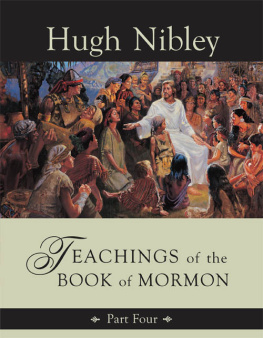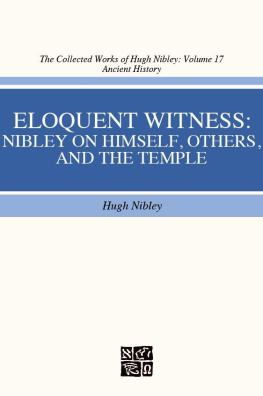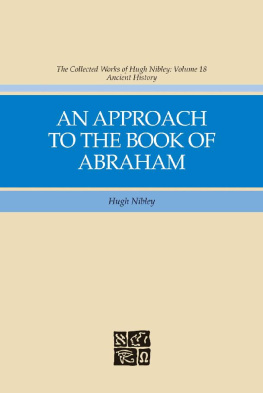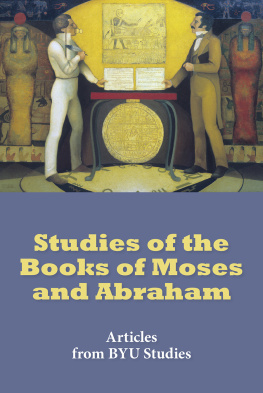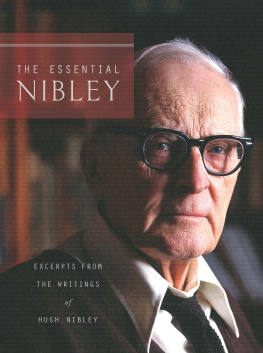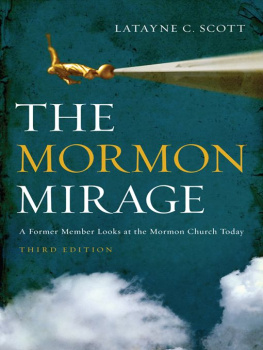
Cover painting Come Unto Me Glen S. Hopkinson.
Cover design 2004 by Covenant Communications, Inc.
Foundation for Ancient Research and Mormon Studies
Brigham Young University
P.O. Box 7113
Provo, UT 84602
2004 Foundation for Ancient Research and Mormon Studies and Nibley LLC
Licensed by Covenant Communications, Inc. All rights reserved.
Printed in the USA.
ISBN 978-1-62108-108-1
SEMESTER 4
Lecture 1 (86) 3 Nephi 6 The Horse in the Americas; War and Prosperity
Lecture 2 (87) 3 Nephi 6 Style of Writing in the Book of Mormon; Pride, Gain, and Power
Lecture 3 (88) 3 Nephi 6-7 Government; Families and Tribes
Lecture 4 (89) 3 Nephi 7-8 Conversion; Signs and Destruction
Lecture 5 (90) 3 Nephi 9 Destruction and Blessings
Lecture 6 (91) 3 Nephi 9-10 The Early Christians; The Five Gospels
Lecture 7 (92) 3 Nephi Resurrection; The Forty-Day Ministry; Reality
Lecture 8 (93) 3 Nephi; Psalm 19 Physical and Spiritual Bodies; Anthropism
Lecture 9 (94) 3 Nephi 9-13 Christs Ministry and Teachings
Lecture 10 (95) 3 Nephi 11-17 Church Membership; Christs Ministry
Lecture 11 (96) 3 Nephi 11-19 Resurrection; The Forty-Day Ministry; Blessing the Children
Lecture 12 (97) [John Welch] 3 Nephi 11 The Sermon at the Temple; Law and Covenant
Lecture 13 (98) [John Welch] 3 Nephi 11 Christ at the Nephite Temple
Lecture 14 (99) [John Welch] 3 Nephi 12-14 The Beatitudes; Christs Teachings
Lecture 15 (100) [John Welch] 3 Nephi 15-18 Sacrament Prayers; Implications of the Sermon at the Temple
Lecture 16 (101) [John Welch] 3 Nephi 19-4 Nephi 1 Understanding the Sermon at the Temple Zion Society
Lecture 17 (102) 4 Nephi 1 Zion Society
Lecture 18 (103) 4 Nephi 1 Prayer; Peace; Prosperity
Lecture 19 (104) 4 Nephi 1:27Mormon 2 Church Growth and Decline; Mormon Leads the Nephites
Lecture 20 (105) Mormon 2-5 Conflicts between the Nephites and Lamanites
Lecture 21 (106) Mormon 1-5 Wickedness in War
Lecture 22 (107) Mormon 8-9 Extinction of Moronis People; Roman Satire; Spiritual Gifts
Lecture 23 (108) Mormon 9 The Book of Mormon and the Ruins
Lecture 24 (109) Ether 1-2 The Epic Literature of the Book of Ether
Lecture 25 (110) Ether 7-14 Struggle for Power
Lecture 26 (111) Ether 2-8 The Boats of the Jaredites
Lecture 27 (112) Moroni 1-10 Formula of Faith, Hope, and Charity; Gifts
TEACHINGS OF THE BOOK OF MORMON
HUGH NIBLEY
Semester 4, Lecture 86
3 Nephi 6
The Horse in the Americas;
War and Prosperity
Last semester we rushed it toward the end to get to the Lords coming to the Nephites, so we are going to have to backtrack a little bit and go back to 3 Nephi 6. We are going to ask a lot of questions this semester, too. Last semester we began with Alma 46. I said that had everything in it. If there was nothing else in the book but that, it would prove the Book of Mormon and give us enough nourishment to go on to the end of time. This is just as good. This chapter contains more historical wisdom in as small a scope as you can ever get it. (Thats a bad sentence, isnt it?) Its the most concentrated form of historical wisdom; it tells us everything. The whole story is right in this chapter, and it especially applies to us. Is Brother Barrows here? Lets read this first verse, and then Im going to ask you why this is a good place to begin. 3 Nephi 6:1: And now it came to pass that the people of the Nephites did all return to their own lands in the twenty and sixth year [note the date], every man, with his family, his flocks and his herds, his horses and his cattle, and all things whatsoever did belong unto them.
Now why is that a good place to begin a story? It ends one phase; it ends the war. Its the end of an epic, and we begin a new phase. Thats exactly the way The Odyssey begins. Now all those who were to be spared destruction had got home, having safely escaped the perils of war and the sea. In the long epic [The Iliad] they go through all the war and trouble. Then it says, now we are going to begin a new story. Its a new beginning, and everybody is safely home. Everybody takes a deep breath. Its a good place to begin after the war, isnt it?
Im caught on one thing. Before I can go any further, youve got to explain something to me. Brother Bentle? This is an underhanded way of taking the roll. Sister Bergeson? See, I dont call roll. Brother Bowen?a good Welsh name. Brother Burdett? Youre heregood for you. What about this business of horses in the Book of Mormon? Has that raised any problems?
It has, according to some of the archaeological scholars.
We cant get any further until weve taken care of horses then, because this is the main crux. This is the strongest argument, supposedly, that has been raised against the Book of Mormon. Well, what about these horses its talking about here? Whats the objection? Why shouldnt they talk about horses? Incidentally, this also introduces us to another thinghow we interpret the words. If you are going to be literal, according to this, every male over the age of twenty owned more than one horse. It says, every man returned to his horses. What that means is every man, such as they were, returned to as many horses as he had, such as they were. They did all returnevery man returned with his family and his horses. Its generic. Whatever men there were that had horses returned to whatever horses they had. This is generic, as it tells us, because it [uses] the indefinite whatsoever; whatsoever man had whatsoever horses returned to whatsoever horses he had.
We are in 3 Nephi 6, and, fittingly, we begin with the third verse, where the bard takes a deep breath (its an epic) and begins another phase of the story entirely. This is a new beginning [following] a definite ending to the war. Everybody has settled down. Everybody is back home and happy. They have returned to their farms. Now we expect a glorious period. Weve got to get rid of this horses business, though, because this worries us, doesnt it? Is there any evidence that Indians had horses? Well, yes, they rode horses all over the plains. Well, when and where did they get those horses? Nobody knows, as a matter of fact. But, first of all, what about horses in Egypt? We know they had them in the New Kingdom because we have pictures of them, but if you go look for horses bones youll never find any--no evidence of that sort.
The classic example, of course, is the camel. Professor Albright, who was the foremost American biblical scholar who ever was, absolutely insisted that people in Abrahams day didnt have camelsthe camel wasnt ridden until the eleventh century. There were no camels. Well, lets ask somebody here. Where do you read about camels in the Bible? Do you remember who rides camels? Remember who was riding away on a camel, and she had the icon hidden under the camels saddle? It goes back to the patriarchal romances. Thats the story of [Jacob] and Rachel. Abraham is placed at 1800-2000 B.C., way back there. In other words, the patriarchal narratives talk about everybody riding around on camels, yet the best scholars say they didnt have camels. Theres no evidence that they had camels. All we have is the written record, but the written record is quite adequate, isnt it? Where did they get the idea of their having camels and riding around on them? All it takes is just one piece of evidence and that changes the whole picture. So you are not going to prove a negative by the absence of something.
But did every man have a horse here? Sister Burton? Brother Buss? What kind of fossil horses do you find in America in the early days? [answer inaudible]. It began in America, didnt it? It was an eohippus, the little tiny thing, not much bigger than a jackrabbit. They wouldnt have ridden those around, so we make jokes about that. But what about the intervening phases? Whats missing? There are all sorts of big gaps in itwhat could have been there and what couldnt. Its very hard to determine these things. It was J. B. S. Haldane, the great British biologist, who said that the evolution of the horse is more certain than the proof of the Pythagorean theorem. Its more certain than any mathematical demonstration. Since he said that, it has been shown that the evidence of the descent of the horse is as full of holes as anything. Theres no unbroken record whatever to be established. But this is the way it goes.
Next page
